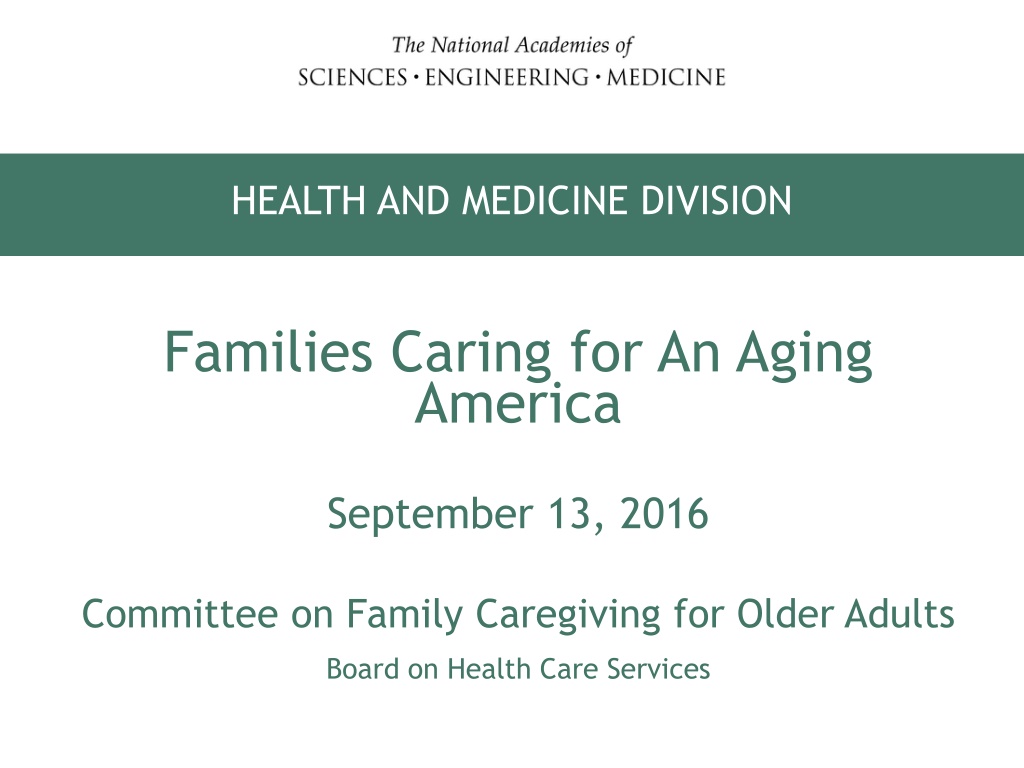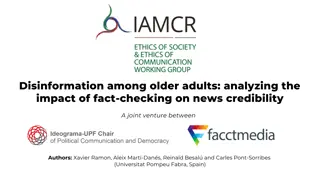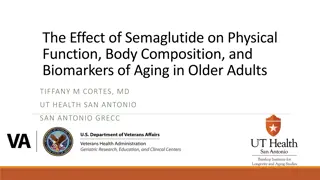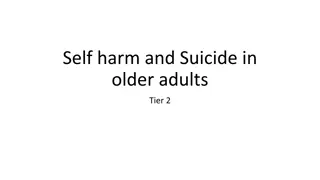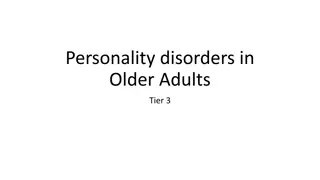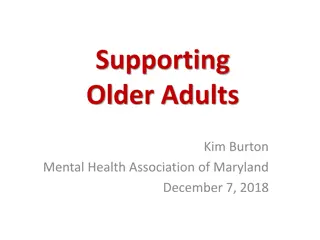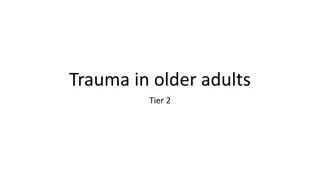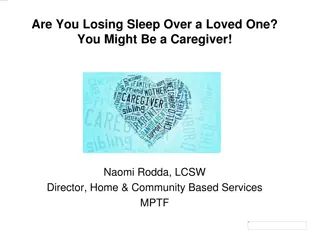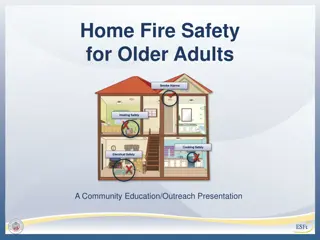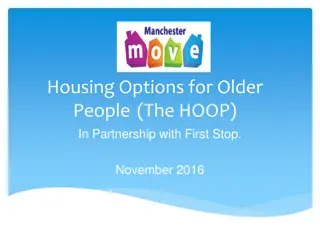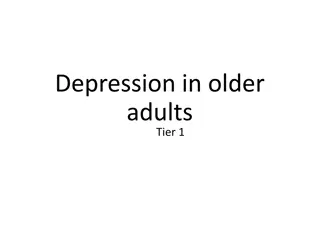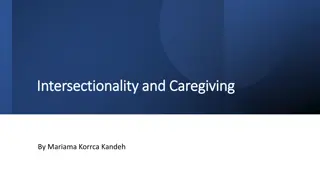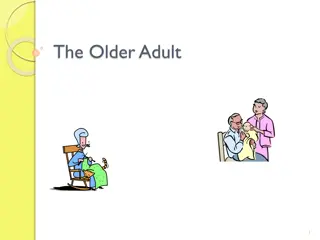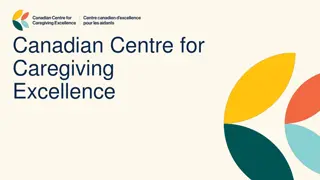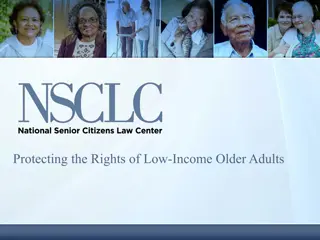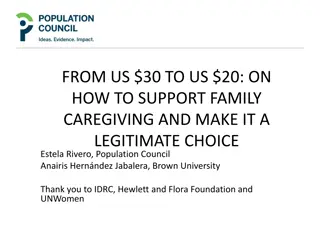Family Caregiving for Older Adults: Addressing Needs and Barriers
This content highlights the significance of family caregiving for older adults as a crucial public policy issue. The committee explores the impact of caregiving on individuals' health, employment, and well-being, aiming to recommend policies to support caregivers and overcome existing barriers.
Download Presentation

Please find below an Image/Link to download the presentation.
The content on the website is provided AS IS for your information and personal use only. It may not be sold, licensed, or shared on other websites without obtaining consent from the author. Download presentation by click this link. If you encounter any issues during the download, it is possible that the publisher has removed the file from their server.
E N D
Presentation Transcript
HEALTH AND MEDICINE DIVISION WATER SCIENCE AND TECHNOLOGY BOARD Families Caring for An Aging America September 13, 2016 Committee on Family Caregiving for Older Adults BOARD ON HEALTH CARE SERVICES Board on Health Care Services
Sponsors of the Study Alliance for Aging Research Alzheimer s Association Anonymous Archstone Foundation California Health Care Foundation The Commonwealth Fund The Fan Fox and Leslie R. Samuels Foundation Health Foundation of Western and Central New York The John A. Hartford Foundation May and Stanley Smith Charitable Trust The Retirement Research Foundation The Rosalinde and Arthur Gilbert Foundation Santa Barbara Foundation Tufts Health Plan Foundation U.S. Department of Veterans Affairs BOARD ON HEALTH CARE SERVICES 2
Committee on Family Caregiving for Older Adults Richard Schulz, Ph.D. (Chair) University of Pittsburgh Ladson Hinton, M.D. University of California, Davis Maria P. Aranda, Ph.D., M.S.W., M.P.A. University of Southern California Peter Kemper, Ph.D. Pennsylvania State University Susan Beane, M.D. Healthfirst Inc. Linda Nichols, Ph.D. VA Medical Center Memphis University of Tennessee Sara J. Czaja, Ph.D. University of Miami Carol Rodat, M.A. Paraprofessional Healthcare Institute, Inc. Brian M. Duke, M.H.A., M.B.E. Main Line Health Charles P. Sabatino, J.D. American Bar Association Judy Feder, Ph.D. Georgetown University Karen Schumacher, Ph.D., R.N. University of Nebraska Lynn Friss Feinberg, M.S.W. AARP Public Policy Institute Alan Stevens, Ph.D. Baylor Scott & White Health Laura N. Gitlin, Ph.D. Johns Hopkins University Donna Wagner, Ph.D. New Mexico State University Lisa P. Gwyther, M.S.W. Duke University Jennifer L. Wolff, Ph.D. Johns Hopkins University Roger Herdman, M.D. Retired BOARD ON HEALTH CARE SERVICES 3
Family Caregiving for Older Adults Although an intensely personal issue, family caregiving has become an urgent public policy issue, linked to important social, health, and economic goals Family caregivers provide the lion s share of long-term services and supports (LTSS) to older adults CBO estimates that the value of family caregiver s services to older adults was $234 billion in 2011 The committee s work calls into question practices that assume the availability of a family caregiver without adequate support services BOARD ON HEALTH CARE SERVICES 4
Charge to the Committee Three primary objectives To assess the prevalence and nature of family caregiving of older adults To assess the impact of caregiving on individuals health, employment, and overall well-being To recommend policies to address caregivers needs and to help minimize the barriers that they encounter in acting on behalf of an older adult BOARD ON HEALTH CARE SERVICES 5
Rapidly rising numbers of older adults and fewer family caregivers to help them Historic demographic changes In 2012, 43.1 million adults age 65+ (13.7% of U.S. population) By 2030, 72.7 million adults age 65+ (>20% of U.S. population) Increasing diversity but national surveys are not powered for subgroup analyses Fastest growing cohort of older adults are those age 80+ When people are most likely to have a physical or cognitive impairment As a result, the demand for caregivers is growing rapidly The gap between the demand for and supply of family caregivers is increasing The size of American families is shrinking and the makeup of families is changing BOARD ON HEALTH CARE SERVICES 6
8.5 million caregivers provide help to 4.9 million high-need older adults (persons with dementia and/or 2 or more self-care needs), 2011 NOTES:As reported by Medicare beneficiaries age 65 and older (or their proxy) for the prior month. Self-care activities include bathing, dressing, eating, toileting, or getting in and out of bed. Probable dementia includes individuals whose doctor said they had dementia or Alzheimer s disease and individuals classified as having probable dementia based on results from a proxy screening instrument and several cognitive tests. Excludes nursing home residents. SOURCE:Data from the 2011 NHATS. BOARD ON HEALTH CARE SERVICES 7
Changing racial and ethnic diversity, U.S. older adults, 2010 to 2040 (in millions) SOURCE: Adapted from Frey, 2014 BOARD ON HEALTH CARE SERVICES
Older adults need for help varies widely The care older adults need may be episodic, daily, occasional, short- or long-term About 6.3 million older adults receive a family caregiver s help with household tasks or self-care because of health or functioning reasons (2011) An additional 3.5 million older adults receive help because they have dementia (2011) 1.1 million reside in nursing homes (2011) but there are very limited data on their family caregivers Some need short-term help after a hospital stay or non- catastrophic injury; others will never need a caregiver s help At least 17.7 million individuals are family caregivers (relatives, partners, friends, or neighbors who assist someone age 65+ with physical, mental, cognitive, or functional limitations) (2011) BOARD ON HEALTH CARE SERVICES 9
Average Number of Years Caregivers of Older Adults Spend Caregiving Percent of Caregivers Years 1 year or less 15.3% 2 to 4 years 5 to 10 years More than 10 years 34.7 34.9 15.1 NOTE: Includes family caregivers of Medicare beneficiaries age 65 and older in the continental United States who resided in community or residential care settings (other than nursing homes) and received help with self-care, mobility or household activities for health or functioning reasons. Respondents were asked How many years have you been helping the care recipient? Responses were given in whole numbers. SOURCE: Data from the 2011 NHATS and the companion NSOC. BOARD ON HEALTH CARE SERVICES 10
The family caregiver role is far more complex and demanding than in the past Family caregivers have always been the primary providers of older adults long-term services and supports such as: Household tasks and self-care (getting in and out of bed, bathing, dressing, eating, or toileting) Today, they are also tasked with managing difficult medical procedures and equipment in older adults homes, overseeing medications, and monitoring symptoms and side effects, and navigating complex health and LTSS systems Including health care services that, in the past, were delivered only by licensed health care personnel (injections, IVs) And, often, without training, needed information, or supportive services BOARD ON HEALTH CARE SERVICES 11
The health impact of caregiving is highly individual and dependent on personal and family circumstances For some, caregiving instills confidence, provides meaning and purpose, enhances skills, and brings the caregiver closer to the older adult. For others, caregiving leads to emotional distress, depression, anxiety, and impaired physical well-being. The intensity and duration of caregiving and the older adult s level of impairment are predictors of adverse consequences. Family caregivers spending long hours caring for someone with advanced dementia are especially vulnerable Other risk factors are low socioeconomic status, high levels of perceived suffering of the care recipient, living with the care recipient, lack of choice in taking on the caregiving role, poor physical health, lack of social support, and a physical home environment that makes care tasks difficult BOARD ON HEALTH CARE SERVICES 12
Family caregiving of older adults poses substantial financial risks for some caregivers Family caregivers of older adults with significant cognitive or physical impairments are at the greatest risk of financial harm Especially if they are low-income, have limited financial resources, reside with or live far from the care recipient, or have limited or no access to paid leave (if they are employed) They may lose income, Social Security and other retirement benefits, and career opportunities if they have to cut back on work hours or leave the workforce They may also incur substantial out-of-pocket expenses that undermine their own future financial security. BOARD ON HEALTH CARE SERVICES 13
Many employed family caregivers do not have unpaid or paid leave benefits at work More than half of family caregivers are employed either part- or full-time Daughters- and sons-in-law, stepchildren, grandchildren, and siblings of older adults are not eligible for the unpaid protections of the Family and Medical Leave Act (FMLA) nor are employees of small firms Federal, state, and municipal laws provide some protections for employed family caregivers, but little is known about their impact on caregivers of older adults or employers BOARD ON HEALTH CARE SERVICES 14
Evidence on an array of interventions to support family caregivers is available The most effective interventions are tailored to caregivers risks, needs, and preferences. Thus, it is clear that caregiver assessment is essential Education and skills training can improve caregiver confidence and ability to manage daily care challenges Counseling, self-care, relaxation training, and respite programs can improve both the caregiver s and care recipient s quality of life. Some research suggests that personal counseling and care management may delay older adults institutionalization and reduce re-hospitalization Numerous barriers limit caregivers access to such services Additional research is needed to determine the effectiveness of interventions in diverse groups of caregivers BOARD ON HEALTH CARE SERVICES 15
Systemic barriers often prevent family caregivers from effectively engaging in the care of older adults Family caregivers interact with a wide range of professionals (from physicians to home health aides) and care organizations (home health agencies, hospitals, pharmacies, nursing homes, and others) Yet they are often excluded from older adults treatment decisions and care planning Even though care providers assume the caregiver is able and willing to perform essential tasks Too often, care providers Do not identify or assess the family caregiver Do not seek critical health information about the older adult from the caregiver Other barriers include payment rules that discourage provider interactions with family caregivers; misinterpretation of HIPAA privacy rules; lack of training to work effectively with family caregivers BOARD ON HEALTH CARE SERVICES 16
Recommendations The focus of the nation s health care reforms should change from person- centered care to person- and family-centered care The Secretary of HHS, working with the Secretaries of Labor and Veterans Affairs, and others should create and implement a National Family Caregiver Strategy that includes (1) mechanisms to ensure that family caregivers are routinely identified in delivery of services to older adults who rely on help (1a) Medicare and Medicaid payment reform to motivate providers to engage family caregivers effectively (1b) training of health care and LTSS providers to engage with and support caregivers (1c) dissemination and funding for evidence-based caregiver services (1d) evaluation and adoption of federal policies that provide economic support to working caregivers (1e) expanded data collection to improve reporting and analysis on the experience of family caregivers (1f) There will be new costs partially offset by saving but requiring rigorous evaluation and transparency BOARD ON HEALTH CARE SERVICES 17
Recommendations contd States that have not addressed the needs of family caregivers of older adults should learn from the states that provide services and supports to caregivers and implement similar programs (2). For example: 14 states have expanded eligibility for the FMLA 4 states have expanded their Temporary Disability Insurance programs to provide partial wage replacement for family leave (include caregiving of older adults) The Secretaries of HHS, Labor, and Veterans Affairs should work with leaders in health care and LTSS delivery, technology, and philanthropy to establish a public-private innovation fund (3) The fund could leverage private funding to accelerate R&D in assistive technologies, remote monitoring and sensing systems, telehealth applications, and other tools to assist family caregivers All the above actions should explicitly address the diversity of older adults and their family caregivers (4) BOARD ON HEALTH CARE SERVICES 18
Questions? Download the report for free at: www.nationalacademies.org/caregiving For more information contact: Jill Eden (jeden@nas.edu) Social media: #nasemcaregiving BOARD ON HEALTH CARE SERVICES 19
